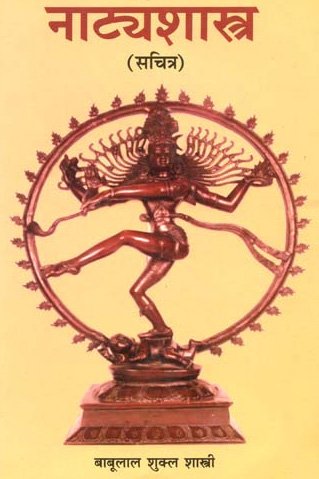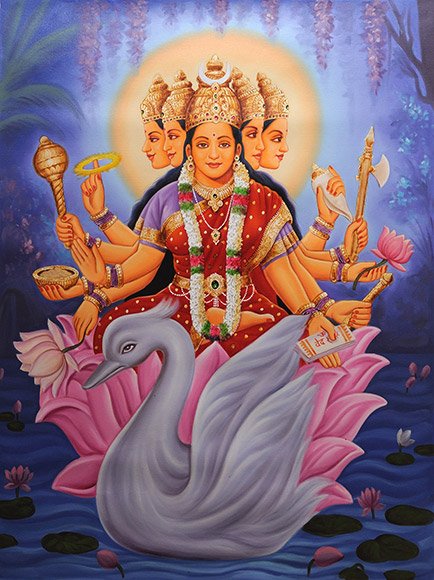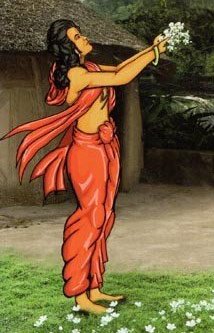Vegavati, Vegavatī, Vega-vati: 8 definitions
Introduction:
Vegavati means something in Buddhism, Pali, Hinduism, Sanskrit, Jainism, Prakrit, the history of ancient India. If you want to know the exact meaning, history, etymology or English translation of this term then check out the descriptions on this page. Add your comment or reference to a book if you want to contribute to this summary article.
In Hinduism
Natyashastra (theatrics and dramaturgy)
Source: Wisdom Library: Nāṭya-śāstraVegavatī (वेगवती) is the name of a meter belonging to the Śīrṣaka class described in the Nāṭyaśāstra chapter 32:—“the metre which has in its feet of twenty-six syllables the fifth, the twelfth, the thirteenth and the last long, is vegavatī”.

Natyashastra (नाट्यशास्त्र, nāṭyaśāstra) refers to both the ancient Indian tradition (shastra) of performing arts, (natya—theatrics, drama, dance, music), as well as the name of a Sanskrit work dealing with these subjects. It also teaches the rules for composing Dramatic plays (nataka), construction and performance of Theater, and Poetic works (kavya).
Chandas (prosody, study of Sanskrit metres)
Source: Shodhganga: a concise history of Sanskrit Chanda literatureVegavatī (वेगवती) refers to one of the twelve ardhasama-varṇavṛtta (semi-regular syllabo-quantitative verse) mentioned in the 333rd chapter of the Agnipurāṇa. The Agnipurāṇa deals with various subjects viz. literature, poetics, grammar, architecture in its 383 chapters and deals with the entire science of prosody (e.g., the vega-vatī metre) in 8 chapters (328-335) in 101 verses in total.

Chandas (छन्दस्) refers to Sanskrit prosody and represents one of the six Vedangas (auxiliary disciplines belonging to the study of the Vedas). The science of prosody (chandas-shastra) focusses on the study of the poetic meters such as the commonly known twenty-six metres mentioned by Pingalas.
Kavya (poetry)
Source: Wisdom Library: KathāsaritsāgaraVegavatī (वेगवती) is the name of a Vidyādharī who transformed herself into Madanamañcukā, according to the Kathāsaritsāgara, chapter 105. Accordingly, “... in the meanwhile an unmarried Vidyādharī, of the name of Vegavatī, having beheld Madanamañcukā in her splendid and glorious beauty, deliberately took her shape, and came and stood alone in the garden under an aśoka tree. Marubhūti saw her, as he was roaming about in search of the queen, and she seemed at once to extract the dart from his pierced heart.”.
The Kathāsaritsāgara (‘ocean of streams of story’), mentioning Vegavatī, is a famous Sanskrit epic story revolving around prince Naravāhanadatta and his quest to become the emperor of the vidyādharas (celestial beings). The work is said to have been an adaptation of Guṇāḍhya’s Bṛhatkathā consisting of 100,000 verses, which in turn is part of a larger work containing 700,000 verses.

Kavya (काव्य, kavya) refers to Sanskrit poetry, a popular ancient Indian tradition of literature. There have been many Sanskrit poets over the ages, hailing from ancient India and beyond. This topic includes mahakavya, or ‘epic poetry’ and natya, or ‘dramatic poetry’.
Purana and Itihasa (epic history)
Source: archive.org: Shiva Purana - English TranslationVegavatī (वेगवती) is the name of a sacred river as mentioned in the Śivapurāṇa 1.12, “somehow men must strive to find a residence in a holy centre. On the shores of the ocean in the confluence of hundreds of rivers there are many such holy centres (puṇyakṣetra or tīrtha) and temples. [...] The rivers Tāmraparnī and Vegavatī accord Brahmaloka. There are holy centres on their banks bestowing heaven on the worshipper. In between these rivers there are meritorious holy centres. Intelligent men residing there will reap the respective fruits thereof”.

The Purana (पुराण, purāṇas) refers to Sanskrit literature preserving ancient India’s vast cultural history, including historical legends, religious ceremonies, various arts and sciences. The eighteen mahapuranas total over 400,000 shlokas (metrical couplets) and date to at least several centuries BCE.
In Buddhism
Mahayana (major branch of Buddhism)
Source: De Gruyter: A Buddhist Ritual Manual on AgricultureVegavatī (वेगवती) refers to the “swift one” as occurring in the Heart-mantra (hṛdayamantra) taught to Vajrapāṇi, according to the Vajratuṇḍasamayakalparāja, an ancient Buddhist ritual manual on agriculture from the 5th-century (or earlier), containing various instructions for the Sangha to provide agriculture-related services to laypeople including rain-making, weather control and crop protection.

Mahayana (महायान, mahāyāna) is a major branch of Buddhism focusing on the path of a Bodhisattva (spiritual aspirants/ enlightened beings). Extant literature is vast and primarely composed in the Sanskrit language. There are many sūtras of which some of the earliest are the various Prajñāpāramitā sūtras.
In Jainism
General definition (in Jainism)
Source: archive.org: Trisastisalakapurusacaritra1) Vegavatī (वेगवती) is the wife of Siṃharatha (son of Mānasavegā and Vidhyādhara-king Vidyudratha from Alakā), according to chapter 5.4 [śāntinātha-caritra] of Hemacandra’s 11th century Triṣaṣṭiśalākāpuruṣacaritra: an ancient Sanskrit epic poem narrating the history and legends of sixty-three illustrious persons in Jainism.
Accordingly, as Megharatha related:—“In this Jambūdvīpa in Bharata in the northern row on Vaitāḍhya there is a fine city Alakā. A Vidhyādhara-king, Vidyudratha, and his agreeable wife, Mānasavegā, lived there. He had a son by her, the tree of whose arm was blooming with power, named Siṃharatha, because of a dream of a chariot with lions for steeds. He married a maiden, Vegavatī, belonging to an eminent family, suitable to himself, like the Moon marrying Rohiṇī. King Vidyudratha made him yuvarāj. For that is a suitable thing for kings to do when the son has reached military age. [...]”.
2) Vegavatī (वेगवती) is the wife of Vidyādhara king Jvalanasiṃha, according to the Jain Ramayana and chapter 7.2 [Rāvaṇa’s expedition of conquest].—Accordingly, as Nirvāṇasaṅgama said to Indra (son of Sahasrāra): “In the past there was a Vidyādhara-chief in the beautiful Ariñjayapura, named Jvalanasiṃha. His wife was named Vegavatī. They had a beautiful daughter, Ahilyā, and all the Vidyādhara-lords came to her svayaṃvara. [...]”.

Jainism is an Indian religion of Dharma whose doctrine revolves around harmlessness (ahimsa) towards every living being. The two major branches (Digambara and Svetambara) of Jainism stimulate self-control (or, shramana, ‘self-reliance’) and spiritual development through a path of peace for the soul to progess to the ultimate goal.
India history and geography
Source: archive.org: Shiva Purana (history)Vegavatī (वेगवती) is the name of a river and is the modern Baiga or Bijari in the district of Madura. See ‘Geographical Dictionary of Ancient and Medieval India’ (N. L. De) P. 38.

The history of India traces the identification of countries, villages, towns and other regions of India, as well as mythology, zoology, royal dynasties, rulers, tribes, local festivities and traditions and regional languages. Ancient India enjoyed religious freedom and encourages the path of Dharma, a concept common to Buddhism, Hinduism, and Jainism.
Languages of India and abroad
Sanskrit dictionary
Source: Cologne Digital Sanskrit Dictionaries: Monier-Williams Sanskrit-English Dictionary1) Vegavatī (वेगवती):—[=vega-vatī] [from vega-vat > vega] f. Name of a river, [Rāmāyaṇa]
2) [v.s. ...] a [particular] drug, [Suśruta]
3) [v.s. ...] a kind of metre, [Piṅgala Scholiast, i.e. halāyudha]
4) [v.s. ...] Name of a Vidyādharī, [Kathāsaritsāgara]
5) [v.s. ...] ([plural]) Name of a class of Apsarasas or celestial nymphs, [Viṣṇu-purāṇa]
Sanskrit, also spelled संस्कृतम् (saṃskṛtam), is an ancient language of India commonly seen as the grandmother of the Indo-European language family (even English!). Closely allied with Prakrit and Pali, Sanskrit is more exhaustive in both grammar and terms and has the most extensive collection of literature in the world, greatly surpassing its sister-languages Greek and Latin.
See also (Relevant definitions)
Starts with: Vegavatistotra.
Ends with: Candavegavati, Mahavegavati, Sarvabalavegavati, Vajravegavati.
Full-text (+11): Janghala, Mahavegavati, Rishta, Adicidambaramahatmya, Bilvavanamahatmya, Arjunapuramahatmya, Vegavat, Ahilya, Vekavati, Prithividevi, Tamraparni, Ashadhapura, Vinadatta, Suryavarta, Taditprabha, Manasavega, Candravarta, Vidyudratha, Jvalanasimha, Prabhavati.
Relevant text
Search found 22 books and stories containing Vegavati, Vegavatī, Vega-vati, Vega-vatī; (plurals include: Vegavatis, Vegavatīs, vatis, vatīs). You can also click to the full overview containing English textual excerpts. Below are direct links for the most relevant articles:
Trishashti Shalaka Purusha Caritra (by Helen M. Johnson)
Part 37: Marriage with Prabhāvatī < [Chapter II - Marriages of Vasudeva with maidens]
Part 30: Reunion with Vegavatī < [Chapter II - Marriages of Vasudeva with maidens]
Part 31: Bālacandrā < [Chapter II - Marriages of Vasudeva with maidens]
Garga Samhita (English) (by Danavir Goswami)
Verse 4.19.9 < [Chapter 19 - A Thousand Names of Srī Yamunā]
Verse 4.19.40 < [Chapter 19 - A Thousand Names of Srī Yamunā]
Verses 2.3.12-13 < [Chapter 3 - Description of the Yamunā’s Arrival]
Kathasaritsagara (the Ocean of Story) (by Somadeva)
Chapter CV < [Book XIV - Pañca]
Chapter CVI < [Book XIV - Pañca]
Note on the position of Book XII < [Book XII - Śaśāṅkavatī]
Chaitanya Bhagavata (by Bhumipati Dāsa)
Verse 3.3.267 < [Chapter 3 - Mahāprabhu’s Deliverance of Sarvabhauma, Exhibition of His Six-armed Form, and Journey to Bengal]
The Garuda Purana (by Manmatha Nath Dutt)
Chapter CCXXIII - The Tripura Vidya < [Dhanvantari Samhita]
Sushruta Samhita, volume 4: Cikitsasthana (by Kaviraj Kunja Lal Bhishagratna)